In today’s digital landscape, social media marketing has become an essential part of any business strategy. Whether you are a small business owner or managing a large enterprise, harnessing the power of social media can help you engage with your audience, build brand awareness, and drive sales. However, effective social media marketing requires more than just posting regularly—it’s about knowing what works and optimizing your efforts.
This blog will provide practical mastering for social media marketing tips, using an equal blend of active and passive voice to keep the narrative engaging and professional.
Define Your Goals and Audience
Before diving into social media marketing, the first step is to clearly define your goals and identify your target audience. Without a defined purpose, it’s difficult to measure success or choose the right strategies.
Set Clear Goals
What do you want to achieve with your social media presence? Common goals include increasing brand awareness, driving website traffic, generating leads, or building a loyal community. Having specific, measurable objectives helps shape your content and approach.
Know Your Audience
It is essential to understand who your target audience is and where they spend their time online. Different social media platforms attract different demographics. Instagram might appeal to a younger audience, while LinkedIn is better suited for professionals. Use social media analytics and surveys to gather data about your audience’s interests, behaviors, and preferences.
Once these two elements—goals and audience—are in place, a social media strategy can be developed that aligns with your overall business objectives.
Choose Right Social Media Marketing Platform
There are countless social media platforms, but not all will be right for your business. Selecting the right platforms will ensure you reach your target audience and optimize your efforts.
Focus on Key Platforms
It’s better to focus on a few key platforms rather than spreading yourself too thin. For example, if you run a visually-driven business, such as in fashion or food, Instagram and Pinterest would be ideal. If you’re in the B2B space, LinkedIn might be more beneficial for reaching decision-makers.
By choosing the right platforms, businesses can engage more effectively with their audience and tailor content to suit the specific platform.
Create Engaging Content
At the heart of any successful social media strategy is content. However, creating engaging, relevant content is easier said than done. Audiences will only respond to content that resonates with them or provides value. So, what types of content work best?
Post Valuable and Relevant Content
Businesses should focus on creating content that educates, entertains, or solves a problem for their audience. Content that resonates with your followers will naturally drive more engagement—whether it’s blog posts, infographics, videos, or user-generated content. For instance, a tech company might post how-to tutorials or industry insights, while a clothing brand could post fashion tips or style inspiration.
Incorporate Visuals
Studies have shown that posts with visuals tend to perform better than text-only posts. Whether it’s eye-catching graphics, photos, or short videos, visual content grabs attention more quickly and leads to better engagement.
Creating and curating content with a strong visual appeal should be a priority, especially on platforms like Instagram, Facebook, and Pinterest.
Consistency is Key
A common mistake in social media marketing is irregular posting. Consistency helps maintain your audience’s attention and fosters engagement. A well-planned posting schedule ensures that your brand remains top of mind.
Develop a Content Calendar
Creating a social media content calendar allows you to organize your posting schedule in advance. This helps ensure that you post regularly and consistently without scrambling to come up with ideas at the last minute.
By planning ahead, content can also be aligned with promotions, holidays, or significant events in your industry.
Post at Optimal Times
Not all posting times are created equal. Each social platform has peak hours when engagement rates are highest. Social media analytics tools, such as Facebook Insights or Instagram Analytics, provide data on when your audience is most active. By posting during these peak times, businesses can maximize the reach and engagement of their content.
Engage with Your Audience
Social media is not just about broadcasting content; it’s a two-way communication channel. Engagement is a vital part of building a loyal online community and strengthening relationships with your audience.
Respond to Comments and Messages
When your audience takes the time to comment or ask questions, it’s essential to respond promptly. Acknowledging their feedback or answering queries builds trust and shows that you value their input. Engaging with followers in this way humanizes your brand and encourages further interaction.
Encourage User-Generated Content
Another effective way to engage with your audience is by encouraging user-generated content (UGC). Running hashtag campaigns or contests where users share their own content related to your brand can increase engagement and create a sense of community.
Sharing user-generated content also adds authenticity to your social media presence and builds trust among potential customers.
Leverage Paid Advertising
Organic reach on social media has become more challenging in recent years, particularly on platforms like Facebook and Instagram, where algorithms favor paid content. Leveraging social media advertising is a cost-effective way to ensure that your content reaches a broader audience.
Use Targeted Ads
Paid social media ads allow businesses to target specific demographics, interests, locations, and behaviors. This level of precision makes it easier to reach your ideal customer and drive conversions.
Facebook Ads, Instagram Ads, and LinkedIn Ads provide in-depth targeting options that can be tailored to your specific audience. When combined with a well-crafted message or offer, paid ads can deliver excellent ROI.
Promote High-Performing Content
If a particular post or piece of content is performing well organically, it may be worth putting ad spend behind it. Promoting content that already resonates with your audience increases the likelihood of higher engagement from a wider audience.
Monitor and Adjust Your Strategy
Social media marketing is not a one-and-done effort. To ensure long-term success, it’s crucial to monitor performance, analyze results, and adjust your strategy as needed.
Track Key Metrics
Metrics such as engagement rates, follower growth, and website traffic provide valuable insights into how your social media efforts are performing. By reviewing these regularly, businesses can identify which strategies are working and which need improvement.
Use Analytics Tools
Social media platforms offer built-in analytics, but using third-party tools like Hootsuite or Sprout Social can provide more comprehensive data. These tools allow businesses to track their performance across multiple platforms, monitor trends, and make data-driven decisions.
Stay Flexible
Social media trends and algorithms change frequently. To stay ahead of the curve, businesses must remain flexible and open to adjusting their strategies. If a particular platform or type of content stops delivering results, it may be time to try something new or refine your approach.
Collaborate with Influencers
Influencer marketing has become a powerful tool for businesses to expand their reach and credibility. By partnering with influencers who align with your brand, you can leverage their audience to promote your products or services.
Identify Relevant Influencers
When selecting influencers, it’s important to choose those whose values and audience align with your brand. Micro-influencers, who have smaller but highly engaged followings, can be more cost-effective for small businesses than major influencers with larger audiences.
Build Authentic Partnerships
The key to successful influencer marketing is authenticity. Influencers should genuinely believe in your product or service, and their promotion should feel natural to their audience. Authenticity builds trust and encourages followers to engage with your brand.
Conclusion
Social media marketing is a dynamic and powerful tool for businesses of all sizes. By setting clear goals, choosing the right platforms, creating engaging content, and staying consistent, businesses can build a strong online presence. Additionally, engaging with followers, leveraging paid ads, and collaborating with influencers will further enhance your efforts.
Success in social media marketing requires continuous monitoring, adjustment, and flexibility to adapt to changing trends and audience preferences. By following these tips, businesses can unlock the full potential of social media to grow their brand, engage their audience, and drive sales.
visit our LinkedIn: https://www.linkedin.com/company/digitalsolutiontech/







Leave A Comment